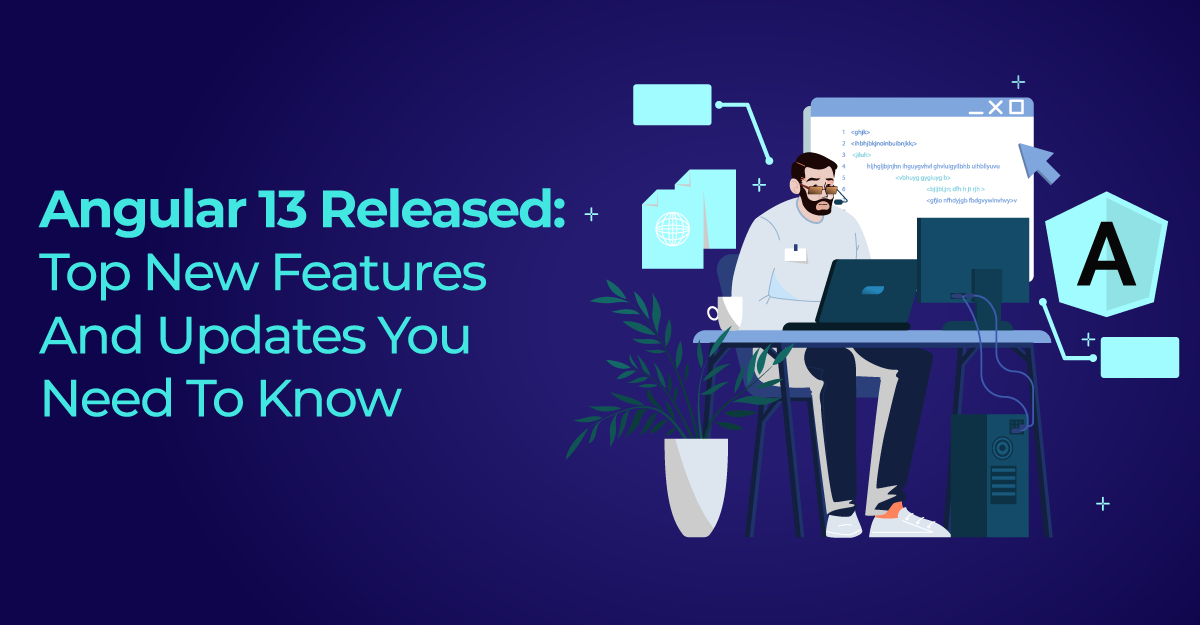The latest upgrade to Google’s popular TypeScript-based web framework, Angular 13 is now available as a production release. The new version of Angular (TypeScript-based free and open-source web application framework), Angular 13, was released on November 3, 2021. Yes! It is the most streamlined and previously planned upgrade. This latest release offers you all sorts of updates and new features needed to build great apps.
Top features and updates of Angular 13
There are many things to know about the latest version of Angular. Following are some of the newly added features and core updates of Angular 13, which makes them better than previous versions.
- Framework and dependency updates Check this link to know more about the changes from version 6 to version 7. In Angular 13, RxJS 7.4 is the default for apps built with ng new, but the existing version uses RxJS v6.x.
- Breaking changes in TypeScript Angular stopped supporting TypeScript 4.2. and 4.3, and Angular 13 - the new release supports Typescript 4.4. This change is useful to keep code clean and safe. The breaking changes in TypeScript 4.4 are control flow analysis, symbols as index signatures, spelling suggestions for javascript, exact optional property types, class static blocks, inlay hints, "tsc --help" updates and improvements, IntelliSense improvements, improved type guard detection, defaulting to the unknown type in catch variables, etc.
- Changes in Angular material component You can see more improvements and changes to Angular Material components. MDC-based components meet the improved a11y standards in areas like contrast, touch targets, ARIA, and more.
- Improved Angular tests The changes in TestBed are another advantage. Angular 13 also enables a new tear-down process for TestBed, which was introduced in Angular 12.1.0. This new process clears the DOM after every test so that developers can expect more optimized, less interdependent, less memory-intensive, and faster tests.
- 100 % Ivy In v13, Ivy opened doors for more optimizations and improvements with some impactful changes. Angular 13 is now 100 percent Ivy (the next-generation compilation and rendering pipeline since v8) which means the legacy View Engine is no longer supported.
- Changes to the Angular Package Format (APF) View Engine-specific metadata and older output formats are removed to modernize the Angular Package Format (APF). Thus maintenance cost and complexity of the codebase are reduced in Angular 13. Here, the focus is to create more Ivy-based features which can improve platform productivity. The dependency of Angular on the ngcc(Angular Compatibility Compiler) is reduced here.
- Ergonomic APIs Angular 13 loads faster than previous versions, with the help of ergonomic code-splitting APIs and granular code breakdown at a component level.
- New features in Angular CLI Angular CLI is the command-line interface tool used to initialize, develop, scaffold, and maintain Angular application development projects directly from a command shell. In this new version, Angular supports the use of persistent build-cache by default. This update results in up to 68% improvement in build speed and more ergonomic options. Check this link to get more ideas about the new features of Angular CLI here.
- Inline support for adobe fonts Angular v11 (2020) introduced support for inlining Google Fonts. This support is now extended to Adobe Fonts. Inlining fonts improve the application performance by speeding up the First Contentful Paint (FCP). Now, this change has become the default for everyone. "ng update" is necessary to experience this.
- End of Internet Explorer 11 support IE11 support removal allows Angular to leverage CSS variables and web animations via native web APIs. Running "ng update" can help you drop these IE-specific polyfills and reduce bundle size during project migration.
- Improvements in localization Some essential changes on angular.io give developers more insights into localization API. Read these localization guides to make the learning journey easy.
- New form type Angular 13 has also highlighted a new form type called “FormControlStatus”.
The release of ESBuild (a highly rapid JavaScript bundler that works with terser to optimize worldwide scripts) is another reason for the high performance. ESBuild performance improvements in the CLI (command-line interface ) reduce the build time by 10%. This JS bundler supports other framework languages like Vue, Svelte, and Elm and allows optimized global CSS also.
How to migrate to Angular 13?
You can get Angular v13 by running ng update in your existing project. Angular workspace configurations can be achieved through some easy steps. You can manually update existing apps that use RxJS v6.x using the npm install rxjs@7.4 command. Angular TestBed updations can be configured per module by updating the TestBed.configureTestingModule method. Check the update guide to get more instructions. You can find the code for the new production on GitHub.
Conclusion
You must give the new Angular 13 a try now that you are aware of the various updates and features. The incredible new features in the stable version of Angular help designers to create rich and superior applications without any issue. Node.js app development services help you build scalable and faster real-time applications.
If you're still using Angular 12, it's worth upgrading to Angular 13 in order to build remarkable apps that adhere to advanced web development specifications. As a Node js development company with 10+ years of experience, IConflux has incredible expertise in creating all-new feature-rich Node.js applications worldwide.



